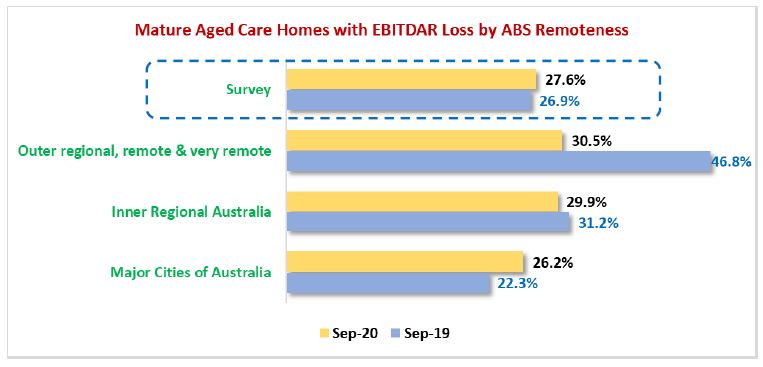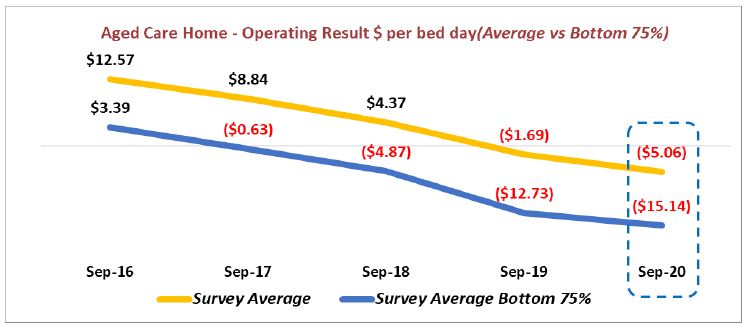The accounting firm’s quarterly Aged Care Financial Performance Survey continues to deliver a bleak insight into the sector’s finances, with 28% of aged care homes recording an operating cash loss during the September 2020 quarter.
 The survey – which looked at 1,140 aged care homes representing 45% of aged care homes in Australia as well as 52,534 home care packages – found that 28% of aged care homes recorded an EBITDAR loss (operating cash loss) for the three months ending 30 September 2020.
The survey – which looked at 1,140 aged care homes representing 45% of aged care homes in Australia as well as 52,534 home care packages – found that 28% of aged care homes recorded an EBITDAR loss (operating cash loss) for the three months ending 30 September 2020.
For the majority of homes in the survey – the Bottom 75% of aged care homes – the operating loss was $15.14 per resident per day.
Outer regional, rural and remote homes also continued to deteriorate, recording an operating loss of 65% with 47% having a cash operating deficit.
COVID funding boosted revenues
The results – which exclude the “significant effect” of the Government’s COVID spending measures to compare ‘apples with apples’ – initially appear to show an improvement.
For FY20, revenue exceeded expenditure by an average of $2.62 per bed day (this increased to $7.66 when COVID revenue was factored in).
This raised the average operating result after COVID revenue and expenditure to a surplus of $2.60 per bed day – compare this to a deficit of $1.69 per bed day for the same period in 2019.
Victorian facilities hit the hardest
However, the average operating result nationally was still a deficit of $5.06 per bed day, in part thanks to the financial hit experienced by Victorian facilities during its second coronavirus wave.
StewartBrown surmises that if the Victorian facilities were removed from the analysis, the results would have been improved to a deficit of $3.48 per bed day.

Average ACFI per bed day (pbd) for participants increased by $4.95 pbd (2.73%) to $185.94 pbd (2.73% pa) but this was overtaken by direct care service costs which increased by 3.2%pa to $157.01 pbd.
Occupancy levels also fell for all survey participants to 91.5% compared to 92.3% for the previous period.
This brought the average Operating Result for aged care homes down by $1,132 per bed per annum (pbpa) to a loss of $1,714 pbpa.
Further investment at risk
StewartBrown warns that: “unless additional specific targeted funding and structural reform is implemented it may lead to closure of residential aged care homes and will risk further necessary investment into the sector.”
They add that the September quarter is historically the best performing quarter from an operating results perspective due to the July COPE (indexation) increase on subsidies – with each later quarter having a declining result.
Of course, we know that more funding is on its way, with the deadline for the Royal Commission’s Final Report now just a month away.
The question is: will it be enough to save more homes from closing their doors?










